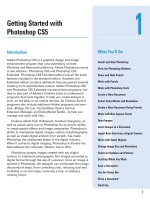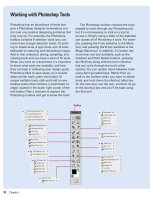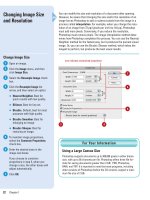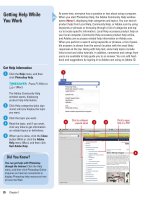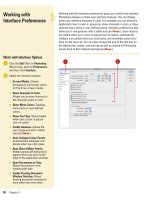Photoshop cs5 by steve Johnson part 31 pps
Bạn đang xem bản rút gọn của tài liệu. Xem và tải ngay bản đầy đủ của tài liệu tại đây (632.17 KB, 6 trang )
ptg
194 Chapter 8
Photoshop gives you many choices when it comes time to add or mod-
ify the colors of a document—paintbrushes, airbrushes, and drawing
tools, just to name a few. Two little-used but powerful tools are the
Stroke and Fill Commands. Both the Stroke and Fill commands work
with selection tools. For example, you may want to create a unique
stroke around an object, or fill a specific area of a document with a
color or pattern. If that's the case, then the Stroke and Fill commands
are the best and fastest ways to perform those operations.
Using the Stroke and
Fill Commands
Create a Stroke
Create a selection using any of
Photoshop's selection tools, or
really get fancy and make a
selection from one of Photoshop's
Shape drawing tools.
TIMESAVER
To further control
the process, perform the stroke (or
fill) operations within a new layer.
Click the Edit menu, and then click
Stroke.
Enter a Width value (1 to 250) for
the stroke.
Click the Color box, and then
select a color (the color box
defaults to the foreground color).
Select a location option (Inside,
Center, or Outside) for the stroke
of the selection marquee.
Click the Mode list arrow, and then
select a blending mode.
Enter an Opacity percentage value
(0% to 100%) for the stroke.
Select the Preserve Transparency
check box to protect any
transparent image areas (if there
are no transparent areas, this
option is disabled).
Click OK.
9
8
7
6
5
4
3
2
1
1
9
3
5
4
8
6
7
2 pixel stroke
applied to the
image.
From the Library of Wow! eBook
ptg
Chapter 8 Understanding Colors and Channels 195
Create a Fill
Create a selection using any of
Photoshop's selection tools.
Click the Edit menu, and then click
Fill.
Click the Use list arrow, and then
select a fill option:
◆ Foreground Color, Background
Color, Color, Content-Aware
(New!), Pattern, History, Black,
50% Gray, or White.
Click the Mode list arrow, and then
select a blending mode.
Enter an Opacity value (0% to
100%) for the stroke.
Select the Preserve Transparency
check box to protect any
transparent image areas (if there
are no transparent areas, this
option is disabled).
Click OK.
7
6
5
4
3
2
1
1
Fill applied to
the image.
7
3
6
5 4
Did You Know?
You can use the Fill command for more
than filling an area with a solid color
or unique pattern.
For example, select-
ing a sepia color, and changing the Fill
Blending mode to Color, tints the
selected area with sepia, creating an
old-style, sepia-toned image.
Experiment with the Fill blending
modes to create unique image effects.
See Also
See “Using Content-Aware Fill” on
page 100-101 for more information on
using the Content-Aware option in the
Fill dialog box.
From the Library of Wow! eBook
ptg
196 Chapter 8
When you work in the world of service bureaus and printing presses,
there are certain things you must do to create an accurate printed doc-
ument. The color mode of the image will be CMYK, and the output of
the document will most likely be in a format designed to create color
plates such as DCS 2.0 (Desktop Color Separations). In addition, you
may want to apply a spot color to the image. Spot colors instruct a
printer to apply a specific color to a specific portion of a document. For
example, you may want to create a book cover jacket, and you want
the author's name in a specific Pantone Blue, or you may want to apply
a varnish to a portion of a brochure. Whatever the case, you will need
to create a spot color channel.
Creating Spot Color
Channels
Create a Spot Color Channel
Open a document.
If the document is not in the CMYK
format, click the Image menu,
point to Mode, and then click
CMYK to convert it.
Create a selection, defining the
area for the spot color. Use any of
Photoshop's selection tools,
including the Type Mask tool.
Select the Channels panel.
Click the Channels Options button,
and then click New Spot Channel.
Click the Color box, and then
select a color.
If you need a specific press color,
such as one from the Pantone
Matching System, click the Color
Libraries button in the Color
Picker, select from the available
color sets, and then click OK.
The Name box displays the name
of the selected color.
Enter a Solidity value (0 %to 100%)
to view the spot color at a specific
opacity (Solidity does not affect
press output).
Click OK.
8
7
6
5
4
3
2
1
76
8
5
4
3
Spot color
From the Library of Wow! eBook
ptg
Chapter 8 Understanding Colors and Channels 197
The Auto Contrast command adjusts the tonality of the image without
impacting color. The Auto Color command adjusts the tonality and color
of the image by ignoring channels and looking directly at the composite
image. The automatic color commands receive their adjustment cues
from information within the active image, including any erroneous color
information. For example, if the image contains a large border (typically
white), the auto commands will factor that information into the correc-
tion of the image. It's best to correct any dust or scratch problems and
crop out any borders before applying the Auto Contrast and Auto Color
commands.
Using the Auto
Contrast and Auto
Color Commands
Use the Auto Contrast Command
Open an image.
Click the Image menu, and then
click Auto Contrast.
IMPORTANT
Use the Auto
buttons (Levels, Contrast, Color)
only if you do not understand how
to manually control the image
using powerful adjustments, such
as Levels and Curves.
Use the Auto Color Command
Open an image.
Click the Image menu, and then
click Auto Color.
2
1
2
1
2
2
Did You Know?
You can use a selection to define how
the Auto Contrast and Auto Color
commands work.
If the image contains
a border, and you don't want the Auto
command using the border to influence
the correction, simply select the
Rectangular marquee and draw a
border around the image. When the
Auto command is applied, only the
selected areas will be adjusted.
From the Library of Wow! eBook
ptg
198 Chapter 8
Through interactive feedback using a Histogram, the Levels adjustment
gives you live information about the tonal values in the active image.
It's an excellent tool to perform overall tonal adjustments and some
color correction. Auto Tone command on the Image menu or Auto but-
ton in the Levels dialog box is considered a quick-fix color adjustment
which, in some cases, works just as well as manually correcting color.
However, the average photo usually has more than one simple problem,
so it's usually best to manually adjust an image. Since the Auto Tone
command or Auto button relies solely on information contained within
the actual image—information that is sometimes inaccurate—it's usu-
ally best to correct the image manually or use a preset level. For exam-
ple, you can use a preset level to make the midtones brighter or darker,
or increase the contrast.
Using Levels
Adjustment
Commands
Adjust Levels
Open an image.
Click the Image menu, point to
Adjustments, and then click
Levels.
To ad jus t levels automatically,
click Auto. Continue with manual
adjustments, or skip to Step 9.
TIMESAVER
Click the Image
menu, and then click Auto Tone.
To se lec t preset mix leve ls, click
the Preset list arrow, and then
select the preset you want.
Click the Channel list arrow, and
then select the composite channel.
Drag the Input Levels sliders to
adjust the brightness level.
Drag the Output Levels sliders to
adjust the level of ink sent to the
output device (printer).
To sa ve settings, click th e Preset
Options button, click Save Preset,
type a name, and then click Save.
Click OK.
9
8
7
6
5
4
3
2
1
3
5
6
7
984
From the Library of Wow! eBook
ptg
Chapter 8 Understanding Colors and Channels 199
Photoshop's Exposure adjustment is primarily designed for performing
tonal adjustments to 32-bit High Dynamic Range (HDR) images, but it
works with 8-bit and 16-bit images as well. The Exposure adjustment
changes an image using a linear color space (gamma 1.0), not the
image's current color space. When used with HDR images, it gives you
the ability to draw out details of the image that otherwise might be
completely lost within the shadows and highlights.
Using the Exposure
Adjustment
Use the Exposure Adjustment
Click the Image menu, point to
Adjustments, and then click
Exposure.
Click the Preset list arrow, and
then select the preset you want, or
select from the following options.
◆ Exposure. Adjusts the highlight
end of the image's tonal scale
with little effect in the extreme
shadows.
◆ Offset. Darkens the shadows
and midtones with little effect
on the highlights.
◆ Gamma Correction. Adjusts the
image gamma, using a simple
power function. Similar to
adjusting the midpoints in an
image's brightness.
Use the eyedroppers to adjust only
the image's luminance values, not
all the color channels, as you
would with Levels or Curves.
◆ Black. Sets the Offset, shifting
the point you click to pure
black.
◆ White. Sets the Exposure,
shifting the point you click to
pure white.
◆ Midtone. Sets the Gamma,
shifting the point you click to
middle gray.
Select the Preview check box to
view changes to the active image.
To sa ve settings, click th e Preset
Options button, click Save Preset,
type a name, and then click Save.
Click OK.
6
5
4
3
2
1
6
42
3
5
Preset list arrow
From the Library of Wow! eBook
